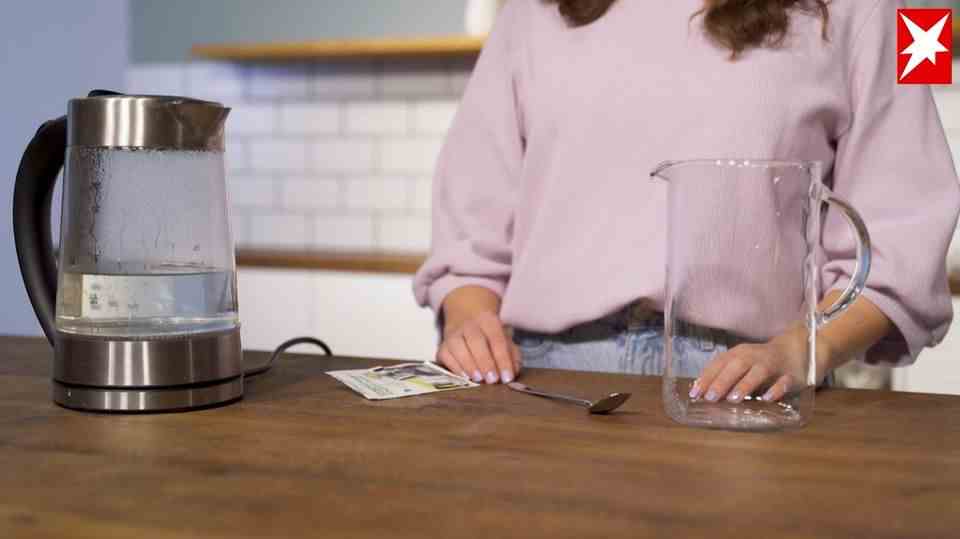Durability & Hygiene
That’s why you should descale your kettle regularly
Kettles will calcify over time if they are not cleaned regularly
© Daisy-Daisy / Getty Images
Depending on the region, the tap water can be particularly rich in lime or poor in lime. The resulting degree of hardness has a significant influence on the hygiene and durability of various kitchen appliances – such as the kettle. Why is that and what can you do about it? We’ll tell you.
The more minerals (i.e. calcium and magnesium compounds) the tap water contains, the higher the degree of hardness. For this reason, one also speaks of soft, medium or hard water. While the latter does not pose any danger to our health, it is the final boss for household appliances. Because the fact is: When water is heated, the lime residues it contains are released and deposited. You can see that and you can taste it – in addition, the kettle has to use more energy and takes more time to boil. If you do nothing against the increasing calcification, the service life of the kitchen appliance will be reduced many times over. It is all the more important to descale the kettle regularly.
How often should a kettle be descaled?
Two factors influence how often you should descale your kettle: On the one hand, the degree of hardness plays an important role, as it has a significant influence on how quickly the first deposits on your kitchen appliance become noticeable. To find out how hard or soft your drinking water is, you can use a endurance test execute. You can then use the following values from the consumer advice center as a guide:
Soft water | Hard water |
Hardness range I | Hardness range III |
0 to 7 degrees of German hardness (dH) | 14 to 21 degrees of German hardness (dH) |
0 to 1.3 millimoles of calcium oxide per liter | 2.5 to 3.8 millimoles of calcium oxide per liter |
On the other hand, the frequency, i.e. how often a kettle is used, also has an influence on limescale deposits. If the drinking water is particularly hard, you should clean the kitchen appliance every two to three weeks. If you use filtered water or soft tap water from the tap, it is sufficient if you descale the kettle twice a year. At the latest, however, when the first white deposits, edges or flakes become visible in the device – especially the heating elements – it is time for descaling.

star
Use descaler for kettles correctly
Commercially available descalers (liquid and solid) can be found in every drugstore as well on-line. The correct dosage is on the manufacturer’s packaging. However, the way of application always remains the same:
- Fill the kettle with the specified amount of liquid and descaler.
- Make sure that all calcified areas come into contact with the mixture.
- Turn on the kettle to heat the mixture in it until it boils.
- Let the water descaler mixture work for as long as the manufacturer specifies.
- Pour the mixture down the sink and fill the kettle with fresh water.
- Boil the fresh tap water (without the descaler) in the kettle again.
- Pour the water down the sink and repeat the process if necessary.
DIY: home remedies for limescale deposits
1. Descale the kettle with citric acid
A classic for descaling kitchen appliances is the citric acid. In contrast to a commercially available descaler, however, this must not be heated in the kettle, otherwise it will react with the limescale and release calcium citrate – an even more stubborn deposit that is difficult to remove. Therefore, proceed as follows:
- Mix the citric acid with the water, the correct mixing ratio can be found on the packaging.
- Let the citric acid-water mixture work for as long as the respective manufacturer specifies.
- Then tip the mixture down the drain and rinse the kettle several times with tap water.
2. Descale the kettle with vinegar essence
Another well-established household remedy is vinegar vinegar essence. While ordinary vinegar is mixed with water in a 1:1 ratio, the essence has to be diluted more: just two tablespoons are 500 milliliters of water. Then bring the mixture to a boil and leave it on for another 30 minutes. But be careful: Do not inhale the steam while heating the vinegar, as it can irritate your eyes and mucous membranes. It is best to open a window so that the steam can escape. Last but not least, the kettle has to be run through several times with clear water and the fresh water in it boiled a few times.
3. Descale the kettle with baking soda
Baking powder is also usually always on hand and can be used to descale a kettle. It contains baking soda, which reacts with water and thus dissolves stubborn deposits. Due to the foaming effect, however, you should use the powder with caution:
- Take a sachet and pour the contents into a kettle.
- Fill the device halfway with water and turn it on.
- Bring the water to a boil and let the mixture soak.
- Pour the cold water away and rinse the kettle.
4. Descale the kettle with baking soda
As already mentioned, the baking soda contained in the baking powder is the key ingredient for descaling a kettle. For this reason, you can also use it pure by mixing 20 grams of loose powder with 200 milliliters of water and boiling it briefly. Here, too, the mixture should then act for at least an hour before you pour it down the drain and rinse the kettle thoroughly several times.
Source: Consumer Center
You might also be interested in:
This article contains so-called affiliate links. There is more information here.


